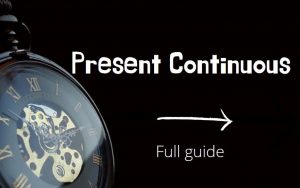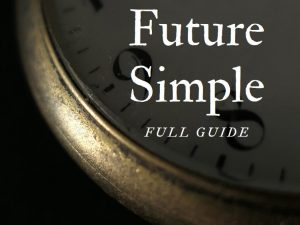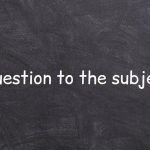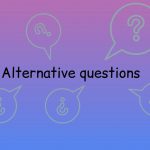We use the Future Perfect Continuous probably less often than all other tenses in English.
But do not think that you don’t need to learn this tense! 🙂
The Future Perfect Continuous is a must for you, believe me. Moreover, learning the Future Perfect Continuous is not at all difficult especially if you already know what the Present Perfect Continuous and the Past Perfect Continuous are.
What is the Future Perfect Continuous?
We use the Future Perfect Continuous to describe an action that will begin in the future, will last for some time until a certain moment or other action, and then will end or continue to last.
Using the Future Perfect Continuous we focus on the duration of the action and not on whether the action is over or not.
Next year we will have been running our own company for 10 years.
To understand what the Future Perfect Continuous is, let’s decipher its name. The name of this tense has its main meaning:
The Future Perfect Continuous.
Future means that the action will take place in the future.
Perfect means that the action will be completed at some point in the future.
Continuous means that this action will be continuous. The action will last before it ends.
The Future Perfect Continuous is something that hasn’t happened yet. The Future Perfect Continuous is something that will last for some time until some moment in the future.
We cannot use the Future Perfect Continuous alone. We need some point in the future to which our action will take place.
I think that by the time when you arrive at the party everyone will have been talking about you.
We can express such a moment in the future using the exact time or it can be clear from the context:
Tomorrow it will have been raining for 10 days.
If you want to understand why we need the Future Perfect Continuous, take a look at these two sentences:
Jessica will come Home tomorrow. John will do his homework tomorrow.
We use the Future Simple in these examples. In this way, we indicate that two simple actions will occur in the future.
But what if we want to show that one action will take place before the second begins?
Yes, sure, we can use the Future Perfect:
When Jessica gets home tomorrow, John will have done his homework.
With the help of the Future Simple and the Future Perfect, we show that one action will start before the second.
But what if we want to show how long one action will last before the second one starts?
This is what we use the Future Perfect Continuous for. In the Future Perfect Continuous, we focus on the duration of the action.
By the time when Jessica gets home tomorrow, John will have been doing his homework for two hours.
And this is the main purpose of the Future Perfect Continuous.
How to form sentences
To form a sentence in the Future Perfect Continuous, we need three main elements.
- The verb to have. We cannot form the Future Perfect Continuous without the verb to have. In the future, the verb to have turned into will have. We use will have regardless of who is the subject.
- I will have
- He will have
- She will have
- It will have
- We will have
- They will have
- You will have
Note: Remember that will have does not change even for the third-person singular. Will has is not correct.
- The third form of the verb to be been. We use been regardless of who is the subject.
- I will have been
- He will have been
- She will have been
- It will have been
- We will have been
- They will have been
- You will have been
- The main verb with the -ing ending. Such a verb shows the duration of the action which is one of the main functions of the Future Perfect Continuous.
We can simply add -ing to some verbs without changing anything:
| base form | verb + ing |
|---|---|
| work | working |
| jump | jumping |
| look | looking |
- work – working
- jump – jumping
- look – looking
The ending of some verbs must be changed before we can add the -ing ending.
| base form | verb + ing |
|---|---|
| tie | tying |
| lie | lying |
| jog | jogging |
| sit | sitting |
- tie – tying
- lie – lying
- jog – jogging
- sit – sitting
Now let’s see how we use these three elements together with the subject to form affirmative (positive), interrogative (question), and negative sentences in the Future Perfect Continuous.
How to form Affirmative (Positive) Sentences in Future Perfect Continuous
To form an affirmative (positive) sentence, we put the Subject first. After the subject, we put the future form of the verb to have will have. Then we put the third form of the verb to be been. Then the main verb with the -ing ending. Then we can add the rest of the sentence if needed.
Subject (I, he, we, John, friends, dog) + will have + been + main verb with the -ing ending (working, playing, walking) + the rest of the sentence.
By 30 I will have been working for ten years here.
I will have been waiting for it for two months.
How to form Interrogative (Question) Sentences in Future Perfect Continuous
To ask a question, we put the auxiliary verb will at the beginning. Then we put the subject. Then have. Then we put the third form of the verb to be been. Then the main verb with the -ing ending. Then we can add the rest of the sentence if needed.
Will + Subject (I, he, we, John, friends, dog) + have + been + main verb with the -ing ending (working, playing, walking) + rest of the sentence.
Will you have been waiting for me all that time before I arrive?
Please note, when we ask a question, we put at the beginning of the sentence only will, not will have!
Correct: Will you have been waiting for me all that time before I arrive?
Incorrect: Will have you been waiting for me all that time before I arrive?
Wh-Questions
A Wh-Question is a question that has additional question words. To ask a Wh-Question in the Future Perfect Continuous, we put a question word or phrase at the beginning of the construction:
Question word or phrase + will + Subject (I, he, we, John, friends, dog) + have + been + main verb with the -ing ending (working, playing, walking) + the rest of the sentence.
How long will you have been staying there before she calls the police?
How to Answer questions
A short positive answer.
Yes + subject (I, he, we, John, friends, dog) + will
Question: Will she have been watching TV all day?
Answer: Yes, she will.
Short negative answer.
No + Subject (I, he, we, John, friends, dog) + will + not
Question: Will she have been watching TV all day?
Answer: No, she will not.
To form a full answer, we add the main part of the question in an affirmative (positive) or nefative form.
Full positive answer:
Yes + subject (I, he, we, John, friends, dog) + will + main part of the question in affirmative (positive) form
Question: Will she have been watching TV all day?
Answer: Yes, she will have been watching TV all day.
Full negative answer.
No + subject (I, he, we, John, friends, dog) + will + not + main part of the question in negative form
Question: Will she have been watching TV all day?
Answer: No, she will not have been watching TV all day.
How to form Negative Sentences in Future Perfect Continuous
To form a negative sentence, we put the subject first. After the subject, we put will and the negative not. Then we add the verb to have and the third form of the verb to be been. Then we put the main verb with the -ing ending. Then we can add the rest of the sentence if needed.
Subject (I, he, we, John, friends, dog) + will + not + have + been + main verb with the -ing ending (working, playing, walking) + the rest of the sentence.
By next year I will not have been living in Tokyo for 10 years. Because I am leaving.
Note: We add the negative not exactly after the auxiliary verb will. Not after have, not after been.
Correct: I will not have been living in Tokyo for 10 years.
Incorrect: I will have not been living in Tokyo for 10 years.
Incorrect: I will have been not living in Tokyo for 10 years.
What is the short form of will?
We use the following types of contractions in the Future Perfect Continuous:
- In an affirmative (positive) sentence, we contract Subject + will as follows:
- I will have been – I’ll have been
- He will have been – He’ll have been
- She will have been – She’ll have been
- It will have been – It’ll have been
- We will have been – We’ll have been
- They will have been – They’ll have been
- You will have been – You’ll have been
- In Negative sentences, we contract the subject + will not like this:
| Full | Short |
|---|---|
| I will not have been | I won’t have been |
| He will not have been | He won’t have been |
| She will not have been | She won’t have been |
| It will not have been | It won’t have been |
| We will not have been | We won’t have been |
| They will not have been | They won’t have been |
| You will not have been | You won’t have been |
- I will not have been – I won’t have been
- He will not have been – He won’t have been
- She will not have been – She won’t have been
- It will not have been – It won’t have been
- We will not have been – We won’t have been
- They will not have been – They won’t have been
- You will not have been – You won’t have been
When to use Future Perfect Continuous?
We use the Future Perfect Continuous when we talk about an action that occurs in the future and will last for some time before some other action in the future.
When you visit us next year, we will have been dating for six months.
Time Clauses
We do not use the Future Perfect Continuous in Time Clauses. Because we don’t use any future tenses in such sentences at all.
Time Clauses are subordinate clauses that begin with words such as:
- while
- before
- as soon as
- if
- unless
- when
- after
- by the time
In such sentences, instead of the Future Perfect Continuous, we use the Present Perfect Continuous.
Non-Continuous Verbs
In English, there is a group of verbs that are called non-continuous, non-action, non-progressive verbs.
These verbs mean:
- Thought processes
- Feelings
- States
etc.
These verbs include:
- to want
- to love
- to hate
- to wish
- to believe
- to remember
etc.
We rarely add the -ing ending to such verbs. Because we cannot see or measure the duration or dynamics of such verbs. Because these verbs describe states or thought processes. We cannot imagine these processes in action.
We can imagine the process described with Action verbs:
John is running.
I am jumping.
We are traveling.
But we cannot imagine, see or feel the process described using non-continuous verbs:
John is loving…
I am wanting…
Therefore, we do not use the Future Perfect Continuous for such verbs. We use the Future Perfect or other tenses that help us correctly express the meaning of the sentence.
Conjunctions of Time by and when
We do not use the Future Perfect Continuous after Conjunctions of Time such as by and when. Because we do not use any future tenses after Conjunctions of Time at all.
We use after Conjunctions of Time the Present Tenses. Even if we assume that the action will take place in the future.
When I finish the project, I will have been working on it for two years.
By the time we come, he will have been waiting there for three hours.
In these examples, we are using the present tenses after Conjunctions of Time, although we are talking about the future.
Difference between Future Perfect Continuous and Future Continuous
Let’s take a look at the difference between the Future Perfect Continuous and the Future Continuous.
With the help of the Future Continuous, we describe an action that will take place at some definite moment in the future.
Tomorrow at this time I will be studying.
We use the Future Perfect Continuous to express an action that starts in the future, lasts for a while, and then ends or continues in the future.
By next year, you guys will have been dating for 5 years.
To see the difference more, look at the following examples:
When John gets home, his mom will be cooking dinner.
We use the Future Continuous in this sentence. This sentence means that when John returns home in the future, his mom will be cooking. We do not know how long she will be doing that. Because using the Future Continuous we focus on what will happen at a specific point in time in the future.
When John gets home, his mom will have been cooking dinner for an hour.
In this sentence, we used the Future Perfect Continuous. This sentence means that by the time John gets home, his mom will HAVE BEEN cooking for an hour. And it doesn’t matter if she will continue to cook the food the moment John comes home, or dinner will be already cooked.
Because using the Future Perfect Continuous we focus not on what WILL HAPPEN at a specified moment in the future, but on what WILL BEGIN BEFORE a specified moment in the future and will last for some time to a specified moment in the future.
Why should we even express an action that starts before some moment? Because sometimes we need to focus on the length of the process.
For example, if we want to show that John’s mom will be tired, then we use the Future Perfect Continuous to emphasize the process that John’s mom will do before John comes home.
If we want to show that something will be in progress at some point in the future, we use the Future Continuous.
If we want to show that something will start earlier than a certain moment in the future and continue until that moment, we use the Future Perfect Continuous.
What is the difference between Future Perfect Continuous and Future Perfect?
We use the Future Perfect when we describe an action that ended at a certain moment in the future, and at this moment the result of this action is visible. For example:
I will have finished this book by next Friday.
In this example, we say that by a certain moment in the future by next Friday the book will be finished.
Now take a look at another example in which we use the Future Perfect Continuous:
I will have been waiting for your call for two days by tomorrow.
In this example, we indicate that the “waiting” action will begin and will continue until the moment in the future “tomorrow” for two days. And it doesn’t matter whether this action ends at the specified moment or will last. Because with the help of the Future Perfect Continuous we focus on the duration and dynamics of the action, not on its result.
The Future Perfect: Emphasis on completeness of action and result.
The Future Perfect Continuous: Emphasis on the duration of the action that started earlier than the specified moment.
If we want to emphasize that at some point in the future we will have the result of some action, then we use the Future Perfect. If we want to emphasize the duration of an action that will begin and will last until a specified moment in the future, then we use the Future Perfect Continuous.
What is the difference between Future Perfect Continuous and Future Simple?
The Future Perfect Continuous is difficult to confuse with the Future Simple. These tenses are quite different. But just in case, let’s take a look at the Future Perfect Continuous and the Future Simple together:
We use the Future Simple when we want to say that some simple action will happen in the future. We do not focus on whether the action will last or not, how long the action will last, or when the action will start, and when it will end. Еhe Future Simple expresses the fact of action itself:
Joon will start a new school in 2 months.
We use the Future Perfect Continuous when we say that some action in the future will start earlier than a specified moment in the future, then last for some time until that moment.
By January John will have been studying at the new school for 3 months.
Markers
Future Perfect Continuous markers are words and expressions that show when the action will begin, how long the action will last, or by what point the action will end:
- when
- before
- till
- until
- all morning
- the whole evening
- all-day
- the whole day
- all week
- the whole week
- all month
- the whole month
- all year
- for an hour
- for 10 hours
- for 5 days
- for 1 week
- for a month
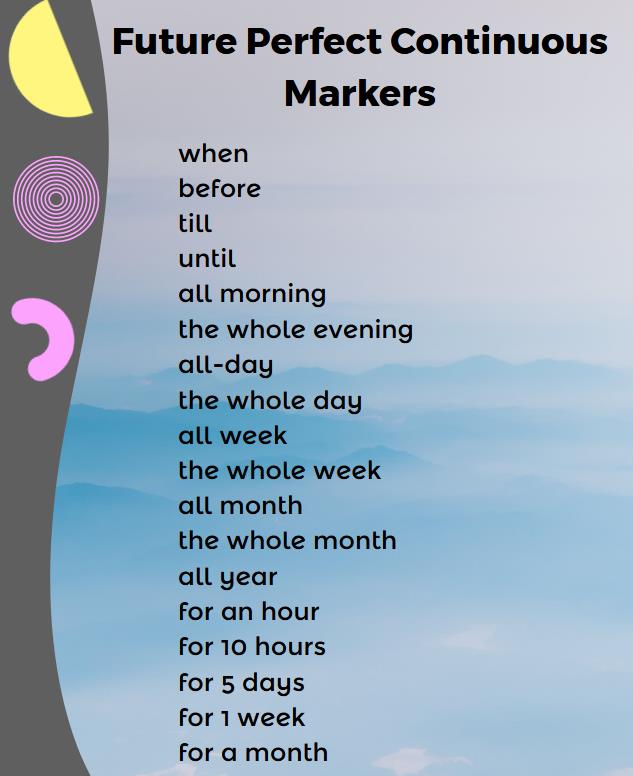
Examples of Future Perfect Continuous
Take a look at the Future Perfect Continuous examples to better understand the lesson.
By 30 I will have been working for ten years.
I will have been looking for it for two months.Tomorrow it will have been raining for seven full days.
I will have been studying it all night.
Everyone will have been talking about your skill.
What will you have been doing with your life?
Remind me please how long will you have been working by that time?
How long will you have been fighting them?
How long will you have been waiting to say something?
By next year I will not have been living in Tokyo for 10 years. Because I am leaving.
When I finish the project, I will have been working on it for two years.
We will have been waiting for this moment for 10 years if needed.


